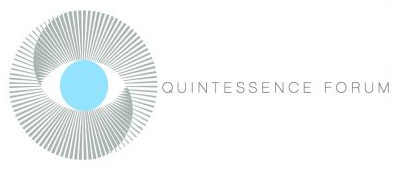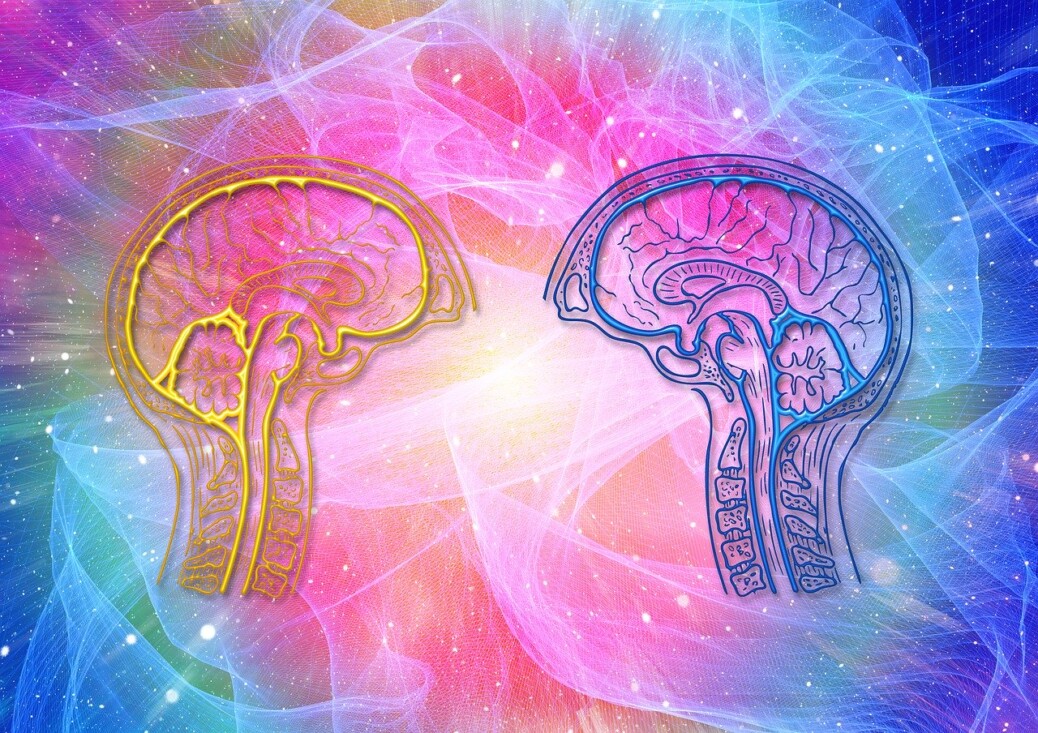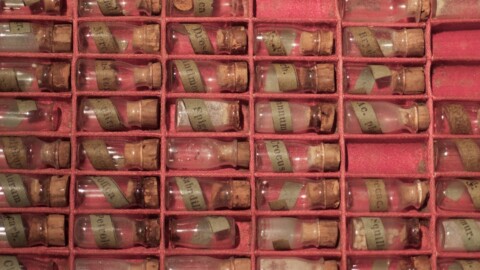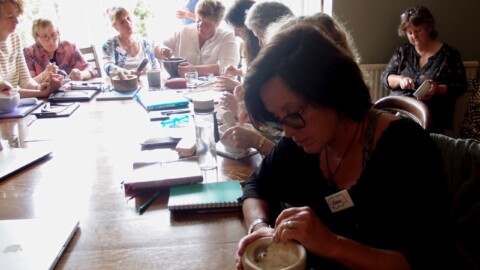Doug Brown, CCH, FNP
It’s not easy for a homeopath to explain what he or she does to the uninitiated. I should know: I’ve encountered bewilderment, patronization, contempt, disbelief, pity, along with the supportive misunderstanding of the uncomprehending but sympathetic. It’s difficult to lose the intimacy of old friendships over the yawning gulf of diverging world-views; but much more important than the occasional loneliness of the homeopath is the fact that so much suffering that could be so gently alleviated through the power of this medicine goes untreated because the dominant paradigm purporting to explain the nature of reality doesn’t allow for homeopathic medicine to be taken seriously by the majority of people in the western world.
I wrote this article in response to what I feel is the obligation of today’s homeopaths to explain what we do in light of contemporary insights into the deep structure of reality. When homeopathy was birthed more than 200 years ago by the brilliant German physician Samuel Hahnemann, he did not have the benefit of the discoveries of Einstein, Planck, Bohr, and Bohm to help him explain his astonishing cures. Homeopathy developed as an empirical, phenomenological discipline, where no causal explanatory model need apply for residence! Yet the thinking, skeptical, rational person of today needs some way of conceptualizing how homeopathy might work before seriously engaging with it.
In this article I present an example of a homeopathic cure. Before my own engagement with homeopathy this case would have seemed to me miraculous. Indeed, there are thousands of published cases of an apparently miraculous nature in the homeopathic literature, many of them far more dramatic than the one presented here.
But apparently seeing is not believing for many people. Deep cognitive structures about how reality works don’t yield easily to repeated anomalies, until an emerging, new paradigm makes sense of these anomalies. Therefore after the case I attempt to contextualize the cure we see in the case by with Sheldrake’s concept of morphogenetic fields, the understanding of wholeness girding the Implicate Order as described by David Bohm, and the potential for applying the quantum physical concept of entanglement to the process of healing through the skillful choice of a homeopathic medicine.
The Case: “I’m Thinking of Shooting My Son!”
“I’m having these homicidal thoughts all the time. Especially when he makes those little autism noises. Sometimes, even when there’s nobody around to annoy me. I’m so scared I’ll become a murderer. I also have suicidal thoughts. I get ragey, violent.”
Mary, a married mother of two young children had been consulting with me for over a year for a variety of symptoms, but this was the first time I became aware of the depth of the pathology and desperation of my patient.
She described more of her intrusive thoughts: “It’s like I’m some sort of scientist in Hitler’s regime, thinking of things to do with babies. I have this image of my older child gouging out the baby’s eyes. Or that he stuck something in the baby’s fontanelle; it went into his brain.”
Regarding her mood, my patient said “Life sucks. Other people are doing other things that are not as boring, physically taxing. Yet this is my life, taking care of these two kids. They’re like drill sergeants, and you’re a prisoner. Whatever the baby says, goes. You’re a slave to whatever the baby needs. I value my independence; I don’t want to be subject to little people. It’s so confining, isolating, lonely.”
My patient, as a child, had a traumatic bond with her schizophrenic mother. Impoverished, she felt very close to her mother, who spent a lot of time with her. Yet her mother was also unpredictably violent. “Once,” my patient remembered, “she just started banging my head into a window. I thought those were my final moments.” Nevertheless, when her mother was admitted to a psychiatric unit my patient, at 5 years of age, fought the separation, and fought the other adults and aunt who assumed her care. “My aunt,” my patient said, “was a lying bitch. She returned to sender the letters my mother sent to me, telling me she never wrote. She kidnapped me. I missed having my own mother, somebody who loves you unconditionally.”
In the present my patient felt increasingly isolated, that she was hated by all her former friends. She had many physical complaints. Many symptoms revolved around her vision: extreme photophobia, floaters, dry eyes. She says:
“I hurt my eye. There was a lot of allergies going around. I kept rubbing it. I started to see sparks, weird flashy things in corner of vision of left eye. The eye doctor said I rubbed it so hard that the gel in my eye peeled away from the retina. My anxiety is high over it.”
Her appetite was poor for nutritious foods, yet she craved junk food, which often led to nausea. She suffered from multiple aches and pains in her joints, especially her knees. She adds, “I still have injuries in my upper spine from a chiropractor.”
At night she slept poorly, and dreamed vividly. In one dream “I had to spend so much time as one particular thing. As a teapot. As a rat. Then move on. My husband wakes me up to nurse. I can’t. I’m a dinosaur! Dinosaurs can’t nurse. It’s not time for me to be something else yet!”
She also had dreams of scary clowns, and of murder.
Another current fear revolved around the cognitive decline. She would forget the name of a friend while speaking with her and has difficulty remembering words.
Two Alternative Models of Disease
One’s framework for understanding health and disease shapes the approach one uses to respond to this crisis. If one assumes that human experience is fundamentally caused by genetic and neurochemical mediators, then one prescribes pharmacologic medication to modify, suppress, or contain disturbing thoughts, feelings, and symptoms.
If, on the other hand, one perceives that the patient has been caught up in a story that was passed down from her mother, and probably many generations before, we might mirror that story back to the patient in a way that can release her from its grip. In this model, the patient’s experience shapes her neurochemistry, rather than the other way around.
Remedies as Medicinal Stories
We are all shaped by stories. I’m not speaking only of the books and movies that make a conscious impact, although these do, indeed, help guide our development as much as the food we eat. I’m referring to the unspoken pain of our elders, to the deferred dreams of our mothers while they carried us in their wombs. I’m thinking of the hopes and fears of our fathers, and the struggles and sensitivities of our teachers and caregivers. We are, each and every one of us, enveloped in a field of meaning, of which we are only partly conscious.
The physicist Rupert Sheldrake coined the term “morphogenetic field” to describe informational patterns which shape biological and social development. By this he means that wherever you have a sustained pattern of structured activity, a field of meaningful information is created. All self-organizing systems, whether it be a plant, a crystal, a molecule, or a society of mammals, both influence and are influenced by, this informational field of meaning. Morphic or morphogenetic fields are like collective memories which are continually evolving as individual participants in the field contribute their experiences to it; in turn, individuals who resonate with this field are also guided in their own development to the degree that they resonate, or vibrate at the same frequency as this field.
Sheldrake developed his ideas in part as a way to understand previously unexplained phenomena. For example:
“There is a lot of circumstantial evidence for morphic resonance. The most striking experiment involved a long series of tests on rat learning that started in Harvard in the 1920s and continued over several decades. Rats learned to escape from a water-maze and subsequent generations learned faster and faster. At the time this looked like an example of Lamarckian inheritance, which was taboo. The interesting thing is that after the rats had learned to escape more than 10 times quicker at Harvard, when rats were tested in Edinburgh, Scotland and in Melbourne, Australia they started more or less where the Harvard rats left off. In Melbourne the rats continued to improve after repeated testing, and this effect was not confined to the descendants of trained rats, suggesting a morphic resonance rather than epigenetic effect.” (1)
Homeopathic remedies can be thought of as quantum links to an informational field that resonates with the patient’s own experience. Illness, whether it be experienced at the physical, emotional, mental, or spiritual level, can be thought of as a question. The informational field, which has accumulated the collective experience of all individuals vibrating at the same frequency, invariably can provide the answer to this question, and bring the individual back into balance.
For this quantum link to be effective, however, it must connect with the right field, the morphic field which the patient needs. Thus the selection of a homeopathic medicine is a highly individualized process.
Perceiving the Form of the Story
Selecting the correct remedy is dependent upon correct, unbiased perception. Like many things in life, it is in part a gift that comes to the homeopath and the patient, via a certain amount of grace. Granted, a great deal of study, training, and experience are prerequisites. But, in the end, it is grace that allows the homeopath to have an “Aha!” moment of revelation that the particulars of the patient’s experience are but a variation of a melody that has been played before, and that is encoded in this rather than some other homeopathic remedy.
Mary attributes her problems to the deprivation of maternal, unconditional love. This is a strong hint that the remedy must relate in some way to the energy of mammals, which embody the quality of mothering more than anything else. Yet Mary’s experience of her mother was a tortured one, hinting that while mammal energy was suggested, a more complex and darker vibration was lurking.
Mary feels she is doomed as if she has a terminal illness. In a dream she spends time as a rat, a teapot, a dinosaur. This reminds me of a micro-organism that passes from one vector to another. The violent imagery of objects sticking into the brain points in the direction of an infection of the brain. What micro-organism commonly affects the brains of mammals, leading them to commit violent acts against the people they depend on, even love?
Rabies! (2)
The Healing Path
Mary was given a remedy made from Lyssinum. Lyssinum is a nosode, a remedy made from a disease product. In this case, that product is the saliva of a rabid dog, which was diluted and agitated so many times that no actual virus remained. However, the informational field of the rabies virus had become imprinted upon the milk sugar with which it was triturated with milk sugar (3), and in the liquid solution in which the milk sugar was dissolved and repeatedly shaken. I asked the patient to take the remedy weekly.
After one month the patient reported that her homicidal thoughts had mostly gone away:
“My health didn’t magically get better, but my sense of control over it did. I feel more like an adult rather than a whiney angsty teen. My anger came way down. I did have some intrusive thoughts; but it’s really easy to push them out of the way.
“The first times I took it I’d feel really happy for 12 hours or so after taking it. A happiness and carefreeness. Like when I was younger, and the world was my oyster. I didn’t feel the weight of the world on my shoulders. I was laughing and giggling with my children. Wanted to do fun stuff. I felt completely unfettered.”
Mary is unfettered. She is telling us that she is leaving the prison cell she had found herself in.
Mary had a follow-up with her ophthalmologist, who, after dilating her eye, found no evidence of the previously detached retina. “The flash has moved way to corner; it’s not coming across my field of vision,” Mary comments.
Mary is grateful for the remedy. She says “I feel a lot more like a woman rather than a shrew. God, I hate being a shrew, Doug! Whenever I see an old woman who’s bitter and angry, I feel compassion. That woman is in pain.” Within herself she is making connections to her experience and the issues of control found in the world of microbiology, pathogens, and host-responsiveness: “The bacteria in your gut tell you to eat ice cream…they want the sugar. The remedy lets you know you don’t need to do this….it’s like saying ‘no’ to the abusive partner you need to break up with. [The remedy] gives you the strength to say ‘no’ to the E. coli bacteria in your bladder which are dying. I feel empowered to make the choices I need to make. Before I felt too weak to do those simple things.”
Implicate Order, Wholeness, and Healing
The late great quantum physicist David Bohm perceived an essential unity and wholeness behind the apparently bizarre nature of quantum reality. He taught that what we perceived with our senses, the “explicate order” of our material world, was a manifestation of an “implicate order” of an enfolded and hidden unitary consciousness (4). Yet this unitary consciousness is not something static and unchanging; rather it is dynamic process, where every unique and individual reality unfolds into the whole, which then enfolds back into the individual. His perspective helps us contextualize the homeopathic healing process as an example of the gentle creation of greater coherence in the way an individual’s energy pattern and consciousness resonate not only with its respective morphogenetic field, but also with his or her immediate environment, including the people within his or her psychosocial ecosystem. Everything, in Bohm’s universe, is an interconnected part of a greater whole.
A similar perspective is offered by the philosopher Bernardo Kastrup. Seeking to make sense of the “hard problem of consciousness” (5), he proposes that there is only cosmic consciousness, that “the inanimate world we see around us is the extrinsic appearance of these thoughts. We, as well as all other living organisms, are but dissociated alters of cosmic consciousness, surrounded by its thoughts.” (6) Could these “dissociated alters of cosmic consciousness” be equivalent to the stories and information embedded in our homeopathic remedies? A remedy is “made” by listening deeply to the spirit or soul of the substance being focused on, Not unlike a shaman who calls forth the voice of the tobacco plant or Ayahuasca, the homeopath makes explicit the information implicit in the manifestation of the element, plant, or animal substance from which the remedy is derived. While the material and potentially toxic aspects of the field’s extrinsic garments are left behind, the remedy itself consists of pure consciousness, albeit a partial consciousness, a story unique to the substance itself.
We have all witnessed how the healing of an individual has salutatory effects on the lives of those with whom he or she mingles. Clearly Mary’s children and husband will be much safer and healthier as a result of Mary’s healing. Indeed, spiritual teacher Thich Nat Hanh’s concept of InterBeing, derived from the ancient Buddhist teachings of dependent origination, highlights the interdependence of all phenomena. Isn’t it interesting that the quantum physical understanding of entanglement mirrors this ancient yet modern understanding of reality?
How do the revelations of the deep structure of reality provided by Quantum physics help us understand how homeopathic medicine works?
Quantum physics, which has revolutionized our ability to describe and predict the behavior of subatomic particles, has also turned on its head many of our most reflexive assumptions about the nature of physical reality. Quantum entanglement, together with the quantum physical concept of complementarity, refers to our ability to answer a question about the state of one particle once we have information about a related particle. “In practice, it turns out that unentangled (independent) states are rare exceptions, for whenever systems interact, the interaction creates correlations between them.(7)” Everything, indeed, is interconnected, and observation leading to consciousness of the state of one entangled system determines the answer for the other system.
Each of us, although obviously composed materially of enormous multitudes of particles, also resonate with some energetic frequencies more than others. Our heart is regulated by an electrical field, as depicted by an electrocardiogram. Our brain produces a multitude of brain waves in connection with the electrical communication among neurons, as demonstrated by electroencephalography. Kirlian photography shows us the multi-layered subtle energy bodies emanated by the body. Each of us consists of a material body enveloped and enfolded in an energetic field which guides our healthy development. And within this field are vast numbers of quantum-entangled sub-atomic particles, sharing the commonality of this field. While the degree to which quantum mechanical effects, proven at the level of subatomic particles, pertain to macroscopic systems such as the human body is still very much yet to be ascertained, it is now undeniable that quantum mechanics has repeatedly demonstrated experimentally a fundamental level of inter-connectedness at the very foundation of our being.
Professor of research methodology, Harald Walach, proposing a quantum mechanic mechanism of action for homeopathic remedies, writes “homeopathy uses two instances of generalized entanglement: one between the remedy and the original substance (potentiation principle) and one between the original symptoms of a remedy picture (similarity principle). By bringing these two elements together, double entanglement ensues, which is reminiscent of cryptographic and teleportation applications of entanglement in QM (quantum mechanics) proper. Homeopathy could be a macroscopic analogue to quantum teleportation.” (6).
Noetic Remedies
The phenomenon of entanglement is not only physical: it is epistemological. The quantum concepts of entanglement and complementarity don’t accurately predict what quantum entangled particles are doing; they predict what we can know about a particle, and how our knowledge can influence and determine a distant particles’ characteristics in apparently time and space-defying ways.
Observation, knowledge, and consciousness are the “active ingredients” of homeopathic medicines. It is the homeopathic practitioner’s meaningful connection of a patient’s signs, symptoms, and experience of the world to the informational field of something else in nature that precipitates the healing in a patient. The healing action is not precipitated by a mechanical, causal, material impact of a pellet on a patient, but rather by a synchronistic pairing of the patient’s state with a balancing field of meaning which resonates with the patient’s state. Thus in many cases it is possible to dispense with the pellets or drop! A “noetic” remedy can be prepared by simply writing the desired remedy and potency on a piece of paper, and placing a glass of water over the message. The ritual of drinking this exposed water often proves effective in initiating a cure.
One beautiful and remarkable case of this was described by my colleague Deborah Collins (personal communication). Deborah’s friend and patient wrote of her experience:
I mentioned that part of the reason I don’t stay in Europe for the winter is because of the cold. Not just that I don’t like it, but it makes me feel like I’m going to die. Even eating or drinking anything straight from the fridge is impossible. I knew that this was a pathological fear as it sets in the moment I feel even slightly cold and it’s an obsessive thought that overwhelmed anything sensible or realistic in terms of possible solutions.
Deborah asked me where the sensation came from and what memory was attached to this feeling, and totally spontaneously I said, “I remember being frozen in a block of ice, a glacier.” She instantly had an idea and jumped up, asking for a small piece of paper. She wrote one word on it, folded it up, and asked me to hold it. Almost immediately, I felt my body temperature rise, my face flush, and I started sweating profusely. I was boiling from the inside out! (9)
Deborah had written the name of the remedy “Camphora”, on the slip of paper, a remedy well-known for the experience of icy coldness. The patient goes on to describe profound changes in her life and deep healing over the next several months, including a move from South Asia back to Europe, where the cold no longer limited her freedom, quality of life, and sense of well-being. We are all participants in stories that far exceed our conscious awareness. Participation in the music of the energies around us equals health and life. Entanglement, however, can lead to the loss of Self due to the overwhelming amplitude of the larger story’s vibration. This larger story – one centered not in our selves, but rather in the consciousness of a non-human element, plant, or animal, has shaped who we are. To the extent we have not been able to become self-aware or become overwhelmed by the experiences it imparts, it imprisons us in pathology. Healing implies a quantum disentanglement from a story that has shaped us, but need not determine our future
Flashes of light recede to a corner. A retina re-attaches to the choroid. A mother laughs with joy with her children. It is all story; it is all consciousness.
We live in a time of the pandemic, yet what is it that is moving among us? Can we move from epidemic to “Posidemic” (10), a way of being that brings greater health to us all? I don’t know, but I sense that there are unplumbed mysteries which may bring us perceptions and remedies that at this moment lie beyond our field of view.
Endnotes:
- https://blogs.scientificamerican.com/cross-check/scientific-heretic-rupert-sheldrake-on-morphic-fields-psychic-dogs-and-other-mysteries/
- The process of witnessing a homeopathic case and analyzing it is far more complex than described here and involves multiple tools, including a “repertory”, a computerized index which correlates symptoms to remedies which are known to be indicated for those symptoms. The bare essentials of this case are presented here for illustrative purposes only. Note that not all cases of homicidal ideation will respond to the rabies remedy: the unique, individual details of the patient’s experience form a gestalt or picture which corresponds to the story being enacted and experienced.
- Trituration refers to the process of mixing and grinding a substance with a diluent, using a mortar and pestle.
- Bohm, David: Wholeness and the Implicate Order. 1980. Routledge and Kegan Paul. New York, NY.
- The “hard problem of consciousness” may be summarized by the question: “Why is it that subjectivity exists at all?”
- Kastrup, Bernardo: The Universe in Consciousness. Journal of Consciousness Studies. 25; No. 5-6. 2018. Pp: 125-55.
- https://www.quantamagazine.org/entanglement-made-simple-20160428/
- Wallach, H. Entanglement Model of Homeopathy as an Example of Generalized Entanglement Predicted by Weak Quantum Theory. Forsch Komplementärmed Klass Naturhelilkd 2003;10:192-200.
- Collins, Deborah. “In From the Cold”. Qjure.com
- Coined, I believe, by Jeremy Sherr.



